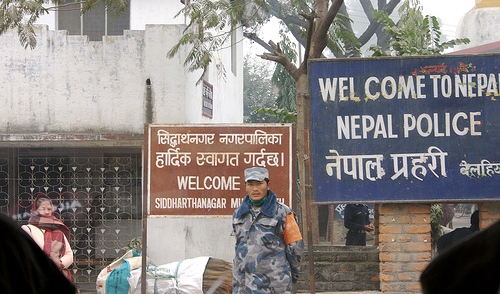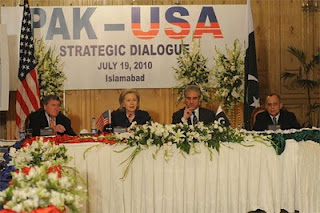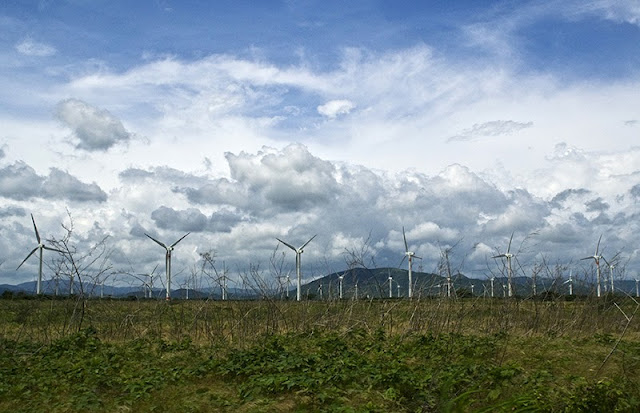-
A Return to Rural Unrest in Nepal?
›July 27, 2010 // By Russell SticklorIn the four years since the end of Nepal’s civil war, political progress in creating a multi-party unity government in Kathmandu has moved in fits and starts. While the effort to bring the Maoists into the fold has made some headway since 2006, continuing environmental and economic troubles in the Nepalese countryside threaten to undermine these tentative steps.
In recent months, a new threat to political stability has emerged: the Sapta Kosi Multipurpose Project, a massive, India-backed hydropower scheme in eastern Nepal currently in the early stages of development. Once operational, the controversial dam—slated to reach a height of nearly 270 meters, making it one of the tallest dams in the world—is projected to generate 3,300 megawatts of electricity.
A proposed barrage and series of canals round out the project, enabling new irrigation and flood-control infrastructure in both eastern Nepal and the Indian state of Bihar, immediately to the south. But the potential environmental impacts of the mega-project have already sparked significant backlash among some Maoist-linked ethnic groups in the region, where the reach and influence of Nepal’s fledgling unity government is tenuous at best.
“Strong” Protests Threatened Over India-Backed Mega-Dam
In June, a network of 15 groups sympathetic to the Nepalese government’s Maoist wing warned of “strong” protests if survey work on the dam continued and “the voice of the indigenous people was not heard.” A memo released by the group dismissed the Sapta Kosi project as “anti-people.”
Specific criticisms of the project have ranged from safety concerns (the dam would be built in a seismically active region) to population displacement. Maoist leaders in the region have alleged that many villages—as well as important local religious sites and valuable agricultural land—could be flooded if the project goes forward. Other Maoists say the project should be delayed until Nepal is reorganized as a federal republic, at which point the states directly impacted by Sapta Kosi could be given greater control over the project.
Meanwhile, some objections to the project have targeted Nepal’s partnership with India. According to ShanghaiNews.net, members of the Maoist opposition have insinuated that hydropower from Sapta Kosi will not be consumed domestically, but rather exported to meet the needs of energy-hungry India.
A number of prominent Nepalese and Indian environmental activists have also spoken against the project, including Medha Patkar, a well-known activist who has played a major role in many past Indian anti-dam protests. Patkar warns the project will not mitigate but instead worsen seasonal flooding, calling plans for the joint India-Nepalese dam project “inauspicious from [an] environmental, cultural and religious point of view,” according to the Water & Energy Users’ Federation-Nepal.
As Nepal Pledges Security for Dam Project, India Pushes Forward
In the past, threats against the Sapta Kosi project have caused surveillance work in the area to be suspended repeatedly. But after the latest round of warnings, the Nepalese government adopted a different tactic, pledging heightened security in the region to ensure the safety of Indian officials doing fieldwork.
In doing so, Nepal’s coalition government is throwing its limited weight around, and—to a degree—staking its reputation on its ability to prevent an outbreak of violence. Historically, Nepal’s government has been largely bypassed or ignored in matters of hydroelectric development. As Nepal Water Conservation Foundation Director Dipak Gyawali told International Rivers in a June 2010 interview:The main players are private investors, with state entities and civil society unable to stand up to them….In Nepal, we just saw local politicians burn down the office of an international hydropower company even after the project was sanctioned by their leaders in the central government.
Gyawali added that during the Nepalese civil war (1996-2006), private developers were able to build “small hydropower projects even while a Maoist insurgency was raging because they did not ride roughshod over local concerns.” Regarding Sapta Kosi, Gyawali said the government should adopt a similar approach, and “start listening to the marginalized voices.” Otherwise, he warned, the Indian-Nepalese team spearheading the project “will be faced with delays, impasse, and intractable political problems,” including the potential for Maoist violence in the region. (As noted earlier this month in New Security Beat, the Indian government has also struggled with Maoist-linked violence in recent years, as New Delhi struggles to pacify a Naxalite insurgency in eastern and central India.)
Rural Nepal’s Troubles Far Bigger Than Sapta Kosi
Maoists may be wielding Sapta Kosi as a weapon to gain political leverage both in the countryside and Kathmandu, but the proposed dam is far from the only environmental issue impacting rural lives and threatening to undermine support for the central government.
In a country where firewood still accounts for 87 percent of annual domestic energy production, deforestation has been hugely problematic across rural Nepal. As of 2010, less than 30 percent of the country’s original forest-cover now remains. The rapid removal of forest cover has reduced soil quality, exacerbated seasonal flooding, and caused degraded water quality due to high sedimentation levels.
Further, as the country’s population grows at an annual rate of 2 percent, low soil productivity and unsustainable farming practices have turned Nepal’s effort to feed itself into a constant uphill struggle. According to the World Bank, the country sports one of the world’s highest ratios of population to available arable land, paving the way for potential further food shortages.
Sustainable energy development in Nepal perhaps represents one way of slowly restoring environmental health to the country. By investing in a more reliable national power grid, the central government could reduce rural dependence on firewood for fuel, allowing the country’s forests, soil, and waters to recover even as population increases. Further, hydroelectric projects like Sapta Kosi—implemented with greater involvement from local communities—could play an important role in moving the country forward. With an estimated untapped hydroelectric potential of 43,000 megawatts, Nepal could not only meet its own energy needs by developing its waterways, but profit from hydroelectric energy exports as well.
On the other hand, the Nepalese government could—at its own peril—continue to overlook rural populations’ grievances, and the environmental degradation unfolding outside Kathmandu. If left unchecked, however, these conditions could once again make the Maoist insurgency an appealing movement, potentially reviving grassroots support for anti-government extremism.
Sources: CIA, eKantipur.com (Nepal), International Rivers, Kathmandu Post, NepalNews.com, New York Times, ShanghaiNews.net, South Asia News Agency, Taragana.com, Thaindian News, Times of India, U.S. Energy Information Administration, WaterAid, Water & Energy Users Federation-Nepal, World Bank, World Wildlife Fund.
Photo Credit: “Neither in Nepal Nor India,” courtesy of Flickr user bodhithaj. -
Landmark Law Takes Aim at the “Resource Curse”
›July 22, 2010 // By Schuyler NullBy signing the financial overhaul package on Wednesday, President Obama also enacted the first major U.S. government attempt to require transparency in the international oil, gas, and mineral trade, aimed at reducing the risk of “resource curse” scenarios that have plagued countries like Nigeria and the Democratic Republic of Congo.
The amendment, sponsored by Senators Bill Cardin and Richard Lugar, requires extractive companies registered with the SEC to publicly disclose their tax and revenue payments to foreign governments. The amendment singles out the DRC for additional scrutiny: companies trading in tin, coltan, wolframite, and gold – minerals found commonly in eastern Congo – will need to report whether they are sourcing from the DRC or its neighbors and disclose what steps they have taken to ensure that their supplies are conflict-free.
The international community will be eagerly watching the results of this effort. Can a U.S. law on conflict minerals reduce violence in the DRC’s complex civil war? I recently argued that while the legislation is a great initial effort, it will have little immediate impact on the violence and suffering in the country. In a recent interview with New Security Beat, EITI expert Jill Shankleman called the Cardin-Lugar bill “an important step” but pointed out that it only covers companies who are listed with the SEC and does not reduce the need for countries to enter into EITI.
Will this new law help Afghanistan – with its allegedly vast stores of valuable minerals – avoid the fate of the DRC? While some fear that corruption and lack of transparency may lead to conflict around the new Chinese contract to operate Afghanistan’s Aynak copper field, a recent U.S. Army War College paper argues that contrary to prevailing opinion, the Chinese approach to large-scale extractive investments could complement Western-led military stabilization efforts.
Photo Credit: “Wolframite” from the DRC, courtesy of flickr user Julien Harneis. -
In Pakistan, Clinton Calls for Human Security; USAID’s Shah Commends Birth Spacing
›July 20, 2010 // By Russell Sticklor In Islamabad yesterday, Secretary of State Hillary Clinton acknowledged longstanding Pakistani concerns that the U.S.’s ongoing mission in the country is solely military in nature. However, Clinton asserted at the opening of the second U.S.-Pakistan Strategic Dialogue that the “future demands a comprehensive human security, a security based on the day-to-day essentials like jobs, schools, clinics, food, water, fuel, equal access to justice, [and] strong, accountable public institutions.” To that end, she announced a $500 million assistance package earmarked largely for new agricultural and hydroelectric infrastructure development, as well as the construction of new hospitals and other health infrastructure.
In Islamabad yesterday, Secretary of State Hillary Clinton acknowledged longstanding Pakistani concerns that the U.S.’s ongoing mission in the country is solely military in nature. However, Clinton asserted at the opening of the second U.S.-Pakistan Strategic Dialogue that the “future demands a comprehensive human security, a security based on the day-to-day essentials like jobs, schools, clinics, food, water, fuel, equal access to justice, [and] strong, accountable public institutions.” To that end, she announced a $500 million assistance package earmarked largely for new agricultural and hydroelectric infrastructure development, as well as the construction of new hospitals and other health infrastructure.
Family planning was another key element in this week’s U.S-Pakistani talks. A U.S. delegation headed by USAID Administrator Rajiv Shah met with top Pakistani health officials to discuss the strategic importance of birth spacing. Both sides agreed that encouraging women to extend the interval between bearing children would not only improve maternal and child health, but also start to bring Pakistani’s population growth rate down to a more sustainable level—a goal fully explored at a recent Wilson Center conference on Pakistan’s population challenge.
As Pakistani demographer Zeba Sathar told New Security Beat in an interview at the conference, educating young women and empowering them to control their own reproductive health will allow them to “take care of their fertility and their family size themselves”—a development that could ease Pakistan’s resource crunch and reduce traditional gender inequities in the years to come.
Sources: Daily Times (Pakistan), International Business Times (U.K.), Los Angeles Times, Times of India, U.S. Agency for International Development.
Photo Credit: “Secretary Clinton Travels to Pakistan,” courtesy of the State Department. -
Stacy VanDeveer: Will Using Less Oil Affect Petrostate Stability?
›July 12, 2010 // By Schuyler NullIf we were to actually use less fossil fuel, what would happen to today’s petrostates? “If the oil revenues dry up or even decline a little bit you might have a real serious crisis,” said Stacy VanDeveer of the University of New Hampshire, during an interview with ECSP. We spoke to VanDeveer following his presentation at the Wilson Center event, “Backdraft: The Conflict Potential of Climate Mitigation and Adaptation.”
-
Time to Give a Dam: Alternative Energy as Source of Cooperation or Conflict?
›July 8, 2010 // By Kayly OberMitigation can be a means to peace, not just conflict, said Stacy VanDeveer in the lead up to Backdraft: The Conflict Potential of Climate Mitigation and Adaptation at the Woodrow Wilson Center on June 10. VanDeveer believes that mitigation techniques, particularly alternative energy sources like hydroelectric dams, could stimulate cooperation rather than exacerbate threats.
-
The United States and China: Clean Energy Friends or Foes?
›July 7, 2010 // By Joshua Nickell As the world moves toward clean energy alternatives, companies in the United States and China are working to develop new, more cost-efficient manufacturing processes and increase their shares of the domestic and export markets for new renewable energy technologies. Controlling production lines and growing market share will certainly have important economic implications for both countries. But over the long term, a broader perspective suggests that cooperative initiatives to increase the capacity and reduce the cost of renewable energy technologies may produce benefits on both sides of the Pacific.
As the world moves toward clean energy alternatives, companies in the United States and China are working to develop new, more cost-efficient manufacturing processes and increase their shares of the domestic and export markets for new renewable energy technologies. Controlling production lines and growing market share will certainly have important economic implications for both countries. But over the long term, a broader perspective suggests that cooperative initiatives to increase the capacity and reduce the cost of renewable energy technologies may produce benefits on both sides of the Pacific.
At an event co-hosted by the Wilson Center on the Hill and the China Environment Forum last month, John Romankiewicz, a senior analyst for China Clean Energy and Carbon Markets at Bloomberg New Energy Finance, and Ethan Zindler, head of North American Research at Bloomberg New Energy Finance, considered the big picture implications for U.S.-China clean energy cooperation and development.
Coming from an investment background, Zindler said that he looks at clean energy development “not as a social project, but as an industry.” The end goal, he asserted, is to produce clean energy more cheaply than fossil fuels. Zindler argued that if clean energy remains prohibitively expensive and uncompetitive without subsidies, it will be more difficult to implement and less likely to produce the desired environmental benefits.
Romankiewicz discussed China’s current supply of and growing demand for energy, pointing out that China’s power grid has grown by more than 70 gigawatts per year during each of the past 5 years, and that “at some point next year, the total installed capacity of China’s grid will surpass that of the United States.”
While coal and hydropower continue to play a significant role in meeting this growing demand, Romankiewicz noted that China also has set ambitious investment targets for wind farms, solar farms, biomass power plants, and other renewable energy sources.
China Looks to Go Global With Renewables
China is investing in clean energy not only to serve growing domestic energy demands, but also to become a major force in the international market, Romankiewicz asserted. Already, China has made impressive advances in clean energy industries: Of the top 15 wind turbine producers, four are Chinese and only two are American. Of the top 10 crystalline-silicon solar cell producers, six are Chinese.
But how will the United States impact China’s drive to become a major player in exporting clean energy technologies? Romankiewicz argued that breaking into the American market could prove exceedingly difficult for Chinese companies given the stiff competition from U.S. companies and other foreign firms.
The speakers also emphasized the importance of understanding the complex global economic implications of clean energy development. “If the Chinese are helping to drive down the cost… then they make solar less expensive,” said Zindler, “which means you can create more jobs in California or New Jersey.” Romankiewicz cautioned against reading too much into the “Made in China” label on clean energy technologies, as the supply chain could include parts from all over the world.
Though he maintained that focusing on the long-term benefits of clean energy investment in the United States would prove beneficial, Zindler advocated for a modicum of urgency. “I think a lot of opportunity would be missed potentially because there is innovation that doesn’t just come from a lab but comes from building newer and newer assembly lines,” Zindler remarked. But in the end, he characterized the U.S.-China battle for influence in the world’s renewable energy market as “a marathon, not a sprint,” asserting that “we’ve got a long way to go to determine who the winner will be in the clean energy race here.”
Joshua Nickell is a staff intern with the Program on America & the Global Economy at the Woodrow Wilson Center.
Photo Credit: <Wind Turbine Manufacture (in China),” courtesy of flickr user ANR2008. -
U.S.-Mexico Cooperation on Renewable Energy: Building a Green Agenda
›Could joint green-energy development help improve relations between the United States and Mexico? Speakers at this spring’s launch of “Environment, Development and Growth: U.S.-Mexico Cooperation in Renewable Energies,” a report released by the Woodrow Wilson Center’s Mexico Institute, agreed that cooperating on renewable energy is a positive step. However, the panelists asserted that cooperation could be maximized by better harnessing Mexico’s renewable resources and by leveraging the economic complementarities that exist among the border states.
Mexico’s Green Energy Potential
Mexico has large untapped areas of geothermal, wind, and solar potential, according to Duncan Wood, author of the Wilson Center report and chair of the Department of International Relations at the Instituto Tecnologico Autonomo de Mexico (ITAM). Already, the country is the world’s third-largest producer of geothermal energy, and has large geothermal deposits in Baja California near major U.S. markets, such as San Diego and Los Angeles.
Mexico also offers great promise in wind power, with an estimated potential output of 1,800 to 2,400 megawatts for Baja California and 5,000 megawatts for southern Oaxaca state. Though Oaxaca is far from the U.S. border, it will soon be able to export electricity to U.S. markets, once Mexico’s mainland electrical grid is connected to the United States.
Wood also pointed out that Mexico is rich in solar energy, which could be marketed to the United States—particularly from the Baja California peninsula, which is the only part of the Mexican grid currently connected the United States. In biomass, he added, little investment has been made so far.
Opening New Avenues for Collaboration
With Mexico’s oil fields experiencing long-term and, in some cases, precipitous declines, the country is plotting a “future as a green nation,” shifting its policy focus toward alternative energy development, said Wood. In addition, Mexico’s renewable sector does have not the blanket prohibitions on private ventures that exist in the hydrocarbons sector, and regulatory adjustments over the past few administrations have enabled a more robust private stake in electricity generation and transmission.
A U.S.-Mexico taskforce on renewables was recently formed—an announcement timed to coincide with President Felipe Calderon’s April 2010 state visit to Washington—and there has been high-level engagement on the issue by both administrations. Collaboration between Mexico and U.S. government agencies through the Mexico Renewable Energy Program has enabled richer development of Mexico’s renewable resources while promoting the electrification and economic development of parts of rural Mexico. Joe Dukert, an independent energy analyst affiliated with the Center for Strategic & International Studies, pointed out that U.S.-Mexico collaboration on renewables is a little-acknowledged area of bilateral cooperation, and stressed the economic complementarities that exist between the two countries on the issue. He noted, for example, that Mexico was well-positioned to furnish power to help California meet its Renewables Portfolio Standard (RPS) by 2020.
Joe Dukert, an independent energy analyst affiliated with the Center for Strategic & International Studies, pointed out that U.S.-Mexico collaboration on renewables is a little-acknowledged area of bilateral cooperation, and stressed the economic complementarities that exist between the two countries on the issue. He noted, for example, that Mexico was well-positioned to furnish power to help California meet its Renewables Portfolio Standard (RPS) by 2020.
“Mexico can help them reach these [renewable energy] targets,” Dukert said. Yet at the same time, he said that Mexico needs to do more to enhance its profile as a renewable-energy supplier, and specifically suggested that energy attaches be assigned to the embassy and consulates.
Johanna Mendelson Forman, a senior associate with the Americas Program at the Center for Strategic & International Studies, emphasized the linkages connecting climate change, energy, and economic development. Forman warned that Mexico’s inadequate energy stocks are a problem for the United States, adding that “energy poverty is a real issue in Mexico.” Energy development and climate change—which are perceived as less polemical than other issues—are good entry points for a broader U.S.-Mexico dialogue, she remarked.
Robert Donnelly is a program associate with the Mexico Institute at the Woodrow Wilson Center.
Photo Credit: “Wind Mill Farm (Mexico),” courtesy of flickr user Cedric’s pics. Speaker photos by David Hawxhurst/Wilson Center. -
Don’t Cry for Me, Argentina: Why a Melting Arctic Needs Stronger Governance
›May 11, 2010 // By Schuyler NullThe Arctic Council, which helps broker economic and environmental agreements between the Arctic nations, needs a larger role in developing joint international policy, says Norway’s ambassador to Canada. Accelerating ice melt is expected to open the Arctic Ocean to seasonal ship traffic sometime between 2013 and 2030 – which analysts worry will lead to disputes over newly accessible oil and gas reserves.
The Arctic Council was founded in 1996 to “provide a means for promoting cooperation, coordination and interaction among the Arctic States” – Canada, Greenland, Finland, Iceland, Norway, Sweden, Russia, the United States, as well as some Arctic indigenous communities are all members. According to the U.S. Geological Survey, the Arctic may contain up to 90 billion barrels of oil (more than the known reserves of Nigeria, Kazakhstan, and Mexico combined) and 27 percent of the world’s known natural gas reserves, most of which is located offshore.
While rhetorical flare-ups over access to resources and accusations of militarization have occurred, to date the Arctic Council has been an effective mitigating body. However, the Council currently lacks a permanent secretariat and reliable funding.
Currently, any territorial disputes are handled under the U.N. Convention on the Law of the Sea (UNCLOS), while the Arctic Council mainly facilitates communication. However the United States has not yet ratified the Law of the Sea, despite concerted high-level efforts to do so.
Referring to the Arctic, Secretary of State Hillary Clinton recently told Congress that “the Law of the Sea provides commercial rights to the mining of what is in the seabed of the territories that are claimable under sovereignty provisions in the treaty,” and if the United States does not ratify it, “we will lose out, in economic and resource rights, in terms of environmental interests, and national security.”
While the National Intelligence Council predicts that a major armed conflict over the Arctic is unlikely in the near future, it suggests that “serious near-term tension could result in small-scale confrontations over contested claims.” A comprehensive agreement brokered by Arctic Council leadership and agreed upon by all members – like the Convention on the Protection of the Mediterranean Sea Against Pollution, and Protocols, which helps regulate commerce and environmental protections – would guarantee third-party moderation and alleviate the risk of an outstanding dispute erupting into real conflict.
The value of such an agreement is illustrated by the growing tension between Britain and Argentina over offshore oil rights around the Falkland Islands. Recent British drilling efforts, which have yielded a pocket of oil worth potentially an estimated $25 billion, provoked a furious response from Argentinean officials who have long disputed Britain’s claims to sovereignty, not only of the islands themselves, but of the seas around them.
Under UNCLOS, a nation is entitled to “explore and exploit” any natural resources within 200 nautical miles of their shores and in certain circumstances can apply for an extension to 350 nautical miles. By these definitions, there is considerable overlap in British and Argentinean claims, which the Law of the Sea alone is unable to resolve.
In a statement reported by the Times Online last week, Foreign Minister Jorge Taiana said that “Argentina energetically refutes what is an illegal attempt to confiscate non-renewable natural resources that are the property of the Argentine people.”
In an earlier bid to slow development, Argentinean President Cristina Fernandez de Kirchner announced in February that any ship coming to or from the disputed islands would have to be granted a permit in order to pass through Argentinean waters, effectively threatening blockade.
The sovereignty of the Falkland Islands has remained a disputed topic for Argentina since the loss of the Falkland Islands War in 1982, made worse by recent financial woes at home and the country’s lack of domestic oil reserves.
Although tensions in the Arctic region are low now, a changing environment and increased competition for energy resources may lead to similar disputes in the polar region – a strong argument for strengthening multilateral institutions like the Arctic Council and UNCLOS sooner rather than later.
Video Credit: “2008 Arctic Sea Ice Minimum w/overlay” courtesy of Flickr user NASA Goddard Photo and Video.
Showing posts from category energy.












